Acupuncture and Moxibustion Course
Extensive clinical education starts in the first year, fostering the development of master-level acupuncture and moxibustion practitioners
| Class | Capacity | Duration | Class Times | Days |
|---|---|---|---|---|
| Day | 30 people | 3 years | 9:30-12:40 (9:30-11:00, 11:10-12:40) | Mon. – Fri. |
| Night | 30 people | 3 years | 18:00-21:10 (18:00-19:30, 19:40-21:10) | Mon. – Fri. |
Examination Eligibility Granted on Completion
On successful completion of the course, students gain eligibility to sit the following national examinations: acupuncture and moxibustion.
To become a master…
The Acupuncture and Moxibustion Course at the Toyoshinkyu College of Oriental Medicine has its origins in the Sorei Shinkyu Juku (Sorei Acupuncture and Moxibustion School) that was founded in 1927. At Toyoshinkyu, we provide education centered on techniques and spirit continued in an unbroken line from our founder Sorei Yanagiya. We produce graduates possessing both the spirit and the technique to establish their own independent practices.
Instructors at Toyoshinkyu have extensive clinical experience and have made a living as clinical practitioners of acupuncture and moxibustion. Toyoshinkyu instructors are generous in their teaching, passionately providing education on the noble spirit and high level of skill required of medical practitioners.
Classes are structured to make it possible to start learning from the most basic fundamentals. Technique acquisition begins with the sharpening of acupuncture needles and the preparation of moxa for moxibustion. Learning then progresses to include the use of the traditional nine types of acupuncture needles, as well as applications for moxibustion burned either directly on the skin or indirectly. The curriculum provides thorough training in the techniques needed for the clinical practice of acupuncture and moxibustion.
Toyoshinkyu is especially unique for including the development of the hands as a part of the basic curriculum. This “development of the hands” is a training method which uses the hands to rub and massage the body, allowing for an exploration of patients’ qi energy and making practitioners’ hands more suited to providing treatments. This training allows for students to gain a firm grasp on a patient’s physical condition and to accurately determine the location of acupoints. Toyoshinkyu is able to provide this kind of education because we have both an Acupuncture and Moxibustion Course, and an Acupuncture, Moxibustion, and Anma/Massage/Shiatsu Course.
In conjunction with this kind of practical training, students start a thorough clinical education (practicum) from their first year. During this practicum, students learn the humility that characterizes a medical care provider, gain the ability for compassion, learn how to interact with patients and their families, and also learn how to determine the cause of a disease and how to provide treatment.
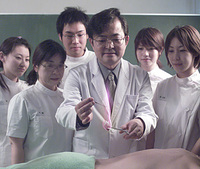
“Fire needling,” a classical acupuncture technique. A large needle is heated until it is red-hot and then inserted.
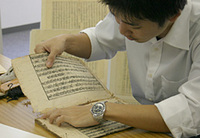
Restoring 500 year old texts promotes a familiarity with and an examination of the Classics.
Curriculum
| Category | Acupuncture and Moxibustion Course | Acupuncture, Moxibustion, and Anma/Massage/Shiatsu Course |
|---|---|---|
| General Basic Subjects | Nutrition, Medical English, Health and Physical Education, Ethics and Psychology, Chinese Classics | |
| Specialized Basic Subjects | Anatomy, Physiology, Introduction to Pathology, General Clinical Medicine, Applied Clinical Medicine, Rehabilitative Medicine, Hygiene and Public Sanitation | |
| Specialized Subjects | Acupuncture and Moxibustion Theory Introduction to Oriental Medicine Introduction to Acupuncture Meridians and Points Clinical Theory of Oriental Medicine Regional Manual Therapies and Clinical Business Management Basic Acupuncture and Moxibustion Technique Acupuncture and Moxibustion Technique Practicum (Fundamental) Clinical Practicum DiagnosticsGeneral Applied (Laws and Ordinances) General Applied (Medical Fundamentals) General Applied (Clinical Medicine) General Applied (Oriental Medicine) Comprehensive Practical Training in Acupuncture and Moxibustion |
Anma/Massage/Shiatsu Theory Introduction to Oriental Medicine Introduction to Acupuncture Meridians and Points Clinical Theory of Oriental Medicine Regional Manual Therapies and Clinical Business Management Basic Acupuncture and Moxibustion Technique Acupuncture and Moxibustion Technique Basic Anma/Massage/Shiatsu Technique Anma/Massage/Shiatsu Technique Practicum (Fundamental) Clinical Practicum DiagnosticsGeneral Applied (Laws and Ordinances) General Applied (Medical Fundamentals) General Applied (Clinical Medicine) General Applied (Oriental Medicine) Comprehensive Practical Training in Manipulative Therapies |
* Course content may vary slightly by academic year
POINT: Special Classes Exclusive to the Acupuncture and Moxibustion Course
Special technique classes are provided during each year of study in the Acupuncture and Moxibustion Course (both day and night sessions). For these classes, instructors from outside Toyoshinkyu are invited to provide instruction into a deeper knowledge of acupuncture and moxibustion, instruction available only to students of the Acupuncture and Moxibustion Course at Toyoshinkyu. Instructors for these special classes are passionate about teaching, have extensive clinical experience, and are leaders of treatments in Japan.
Acupuncture and Moxibustion Course Special Classes
First Year Palpation of meridians and determining acupoint locations
Second Year Instructor: Oura The Sugiyama-Shinden Style and other traditional Japanese schools: techniques and contact acupuncture
Third Year Special practicum classes for the Acupuncture and Moxibustion Course provided by instructors representing various acupuncture techniques and schools in the acupuncture community
Instructor: Tomobe “First, Dispel Doubt” “Lecture on Old Text Revival”
Instructor: Daikoku Psychology for Pediatric Acupuncture
Instructor: Suzuki Acupuncture in the Palliative Care Department of a Cancer Hospital
Instructor: Kagaya Clinical Practicum with the Nan Jing Classic
Instructor: Hamada Low Frequency Electro-Acupuncture
Instructor: Toyabe Fundamentals of Pulse Diagnosis
Instructor: Shinohara Benefits of Single Needle Treatments
*The above is a list of lectures and classes provided during the previous academic year. Content may vary by academic year.
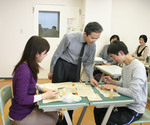
Tomobe
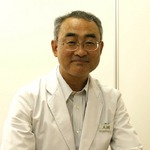
Oura
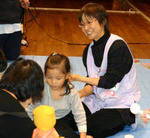
Daikoku
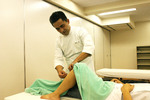
Shinohara
A Message from Toyoshinkyu Teachers
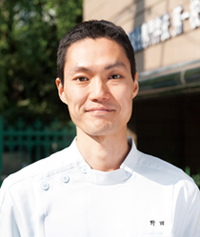
Ryo Noda, Department Chair
Acupuncture and Moxibustion Course
Aim to become an acupuncture and moxibustion specialist
The Acupuncture and Moxibustion Course specializes in two areas: acupuncture and moxibustion. Toyoshinkyu fosters the development of “Acupuncture and Moxibustion Specialists,” people who possess a deep level of knowledge in the field of acupuncture and moxibustion, specialists who are able to be active in a wide range of areas. The Acupuncture and Moxibustion Course has 240 more hours of practical acupuncture and moxibustion curriculum than the Toyoshinkyu Acupuncture, Moxibustion, and Anma/Massage/Shiatsu Course, leading to the acquisition of sound technique (from basic to applied technique). Moreover, there are classes on applied techniques and specialized needle skills that are only offered in the Acupuncture and Moxibustion Course. We are waiting to welcome students to Toyoshinkyu who seek to master the technique and path (Tao) of acupuncture and moxibustion.
Toyoshinkyu offers special classes in the Acupuncture and Moxibustion Course on developing the hands to find acupoints on the meridians in anma/massage/shiatsu.
Student Interview: Kohei Nonaka (Night Class, Third Year)
Proud to say “Toyoshinkyu”Q: Why did you decide to become a practitioner of acupuncture and moxibustion?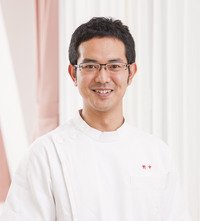
A: I became interested in acupuncture and moxibustion after seeing different conditions improve at the clinic where I was working as a Judo Therapist (Judo Seifukushi), so I decided to become a practitioner of acupuncture and moxibustion.
Q: Why did you choose Toyoshinkyu?
A: Of the many specialized training colleges in the field of medicine, Toyoshinkyu was the only school that provided many special classes, and was the only school where I could learn traditional oriental medicine and many treatment techniques. Of course, Toyoshinkyu offers a significant amount of practical training and clinical practicums, but I also felt Toyoshinkyu offered all the aspects of acupuncture and moxibustion that are possible to learn. There was no doubt for me when I decided on Toyoshinkyu.
Q: What do you think now that you are learning at Toyoshinkyu?
A: Many of the teachers and instructors are renowned in the field of acupuncture and moxibustion. It has been very stimulating to be able to learn many different treatment methodologies.
I was also able to learn not only about acupuncture and moxibustion, but also about nutrition. My first year of study was over before I knew it. I hope to enjoy my remaining year even more.
Q: What are your post-graduation plans?
A: I plan to thoroughly study acupuncture and moxibustion, with the goal of opening an acupuncture, moxibustion, and osteopathic clinic in five years, a clinic that primarily provides acupuncture and moxibustion treatments.
Student Interview: Alicia Kaneshiro (Day Class, Second Year)
I want to found a school in Peru where people can learn Japanese acupuncture and moxibustionQ: Why did you decide to become a practitioner of acupuncture and moxibustion?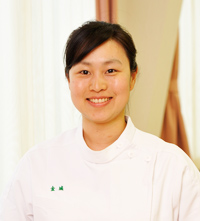
A: Ever since I was a child, I have been troubled with issues of class and inequality in countries and communities. When thinking about whether there was anything I could do to contribute, no matter how small, I found acupuncture and moxibustion, as well as oriental medicine. I thought that if I could learn this and share it with the world, then I could help people become happier, even if in a small way. This is why I chose to pursue the path to becoming a practitioner of acupuncture and moxibustion.
Q: Why did you choose Toyoshinkyu?
A: Two things were the deciding factors. One, the acupuncturist at the clinic I visited said, “If you are going to learn acupuncture and moxibustion you should go to Toyoshinkyu College of Oriental Medicine where you can learn the Classics.” Two, the Toyoshinkyu Principal has a personality that is as warm as the sun.
Q: What do you think now that you are learning at Toyoshinkyu?
A: Just being able to learn authentic meridian-based treatments and study the Classics is more than enough for me to be able to say I am glad I chose this school. The extensive library collection is also something I like.
Q: What are your post-graduation plans?
A: I am a Peruvian with third-generation Japanese roots so I would like to start spreading Japanese acupuncture and moxibustion in my home country of Peru, eventually expanding into the countries of Central and South America. In time, I would like to establish a facility where people can learn about Peru’s medicinal herbs, treatments with acupuncture and moxibustion, and exercise and diet interventions, so that more people can live healthy and happy lives.
Detailed Information on Entrance Exams and Tuition
• Entrance Exam Details (Japanese)
• Tuition and Student Loans (Japanese)
• School Information Session (Japanese)


